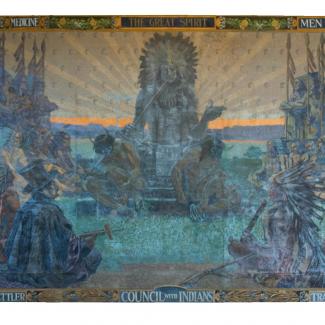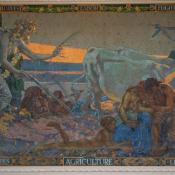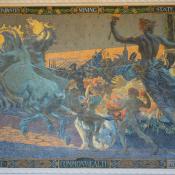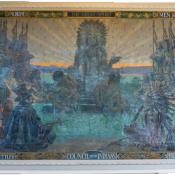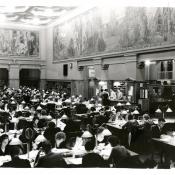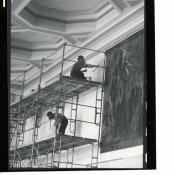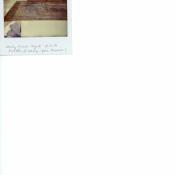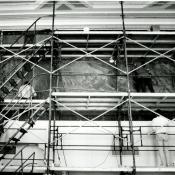Series of three panels entitled "Glory and Grandeur of Iowa" that were commissioned by the ISTC Board after the installation of the first two murals in 1920. The board paid William de Leftwich Dodge an additional $10,000 to produce these three panels for the west wall of the reading room. He had them completed by September of 1921 and their cost made up 9% of the total cost of the building.
The three panels are:
"Agriculture"
This painting represents prehistoric Iowa when life consisted of the American Indian and animal and bird life of that period. In this painting the artist emphasizes the importance and worth of soil as a fundamental basis of future prosperity. The chief allegorical figure of Ceres, the Goddess of Grain, plowing with two white oxen, representing labor and action that will produce a wonderful harvest on this delta soil between the majestic rivers, and where the glacial epochs of many years produced the results that have made agriculture a business that will sustain a happy and successful population. The Indians in the foreground and the birds on the ground and in the air typify what existed before the civilization of the white man came."
"Council of Indians"
This painting consists of an exhibition of the peaceful way in which the white man in Iowa superseded the red man. The central figure is an allegorical one representing 'The Great Spirit,' the God of the Indian. This figure is surrounded by the Medicine Men on the platform interpreting the wishes of the Great Spirit that the new civilization should take place in this territory. The uplifted hand hand of the Great Spirit here shown is indicative of approval. The pipe of peace is being smoked by the members of the Council in session while the warriors in the background stand in form to see that the conference is properly conducted. At the left is a chief of the Iowa Indians and behind him a warrior in the posture of peace. Behind is the friendly scuffle of the white and Indian boys. The settlers are garbed in the costumes of 1841 and the whole scene is one of peace and promise. The single squaw in the wigwam is preparing refreshments for the members of the conference after the agreement and ceremonies are completed.
"The Commonwealth"
This painting indicates the grand procession that civilization organized when the white people came and inaugurated government, law and business. The white horses represent destiny drawing in an elaborate chariot the State as organized personality, her hands holding the lines but not controlling the steeds and Progress holding the torch before the State as an indication of the way to go to secure abounding success. Agriculture is represented by trophies on the chariot, Industry and Mining are represented by the marching hosts in the background, and Action is represented by the whole demonstration. The past is shown by the Indians at the left shading their eyes in order that they may safely look upon the brilliance and grandeur of the great procession."
Quotes comes from 1927 Bulletin of ISTC, The Library (1972.54.2)
The artist, Henry de Leftwich Dodge was born in Bedford County, Virginia in 1867 and was taught by his mother to be a painter at an early age. He moved to Paris shorty after his birth and spent his youth living between Paris and Munich. He tutored under Jean-Leon Gerome in the Ecoles des Beaux-Arts and won awards and medals for his work. He stayed in New York for most of his life and created artwork across the country. He died in 1935.

